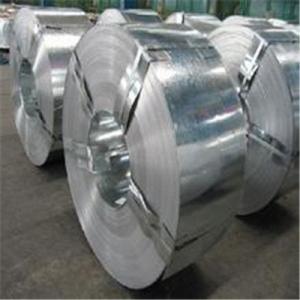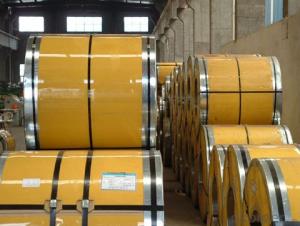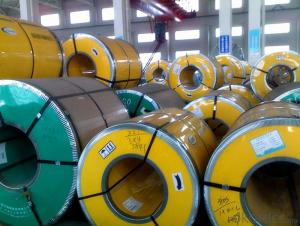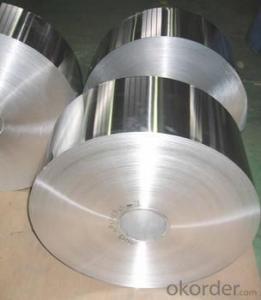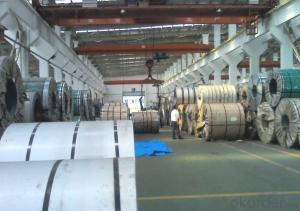Hot Rolled Steel Strip Coil with Hardened&Tempered
- Loading Port:
- Tianjin
- Payment Terms:
- TT OR LC
- Min Order Qty:
- 77 m.t.
- Supply Capability:
- 2222777 m.t./month
OKorder Service Pledge
OKorder Financial Service
You Might Also Like
Item specifice
Applications of Steel Strip Coils:
1:Chemical industry equipment, Industrial tanks
2:Medical Instruments,Tableware, Kitchen utensil,kitchen ware
3:Architectural purpose, Milk & Food processing facilities
4:Hospital Equipment, interior Exterior decoration for building
5:Architectural purposes, escalators, kitchen ware,vehicles
Festures of Steel Strip Coils:
1. Each coil is closely covered by oil paper or plastic film.
2. Outside it is firmly packed with sack cloth or compound paper.
3. Steel strap or PP strap to pack the outside to ensure safety.
4. On/about 1000kgs to be packed with one wooden pallet.
5. Strips can be loaded to 20'FCL without pallet if required by customer.
6. LCL shipment can also be arranged once required by the customer.
Specifications of Steel Strip Coils:
Hardened&tempred steel strip, high carbon 65Mn, HRC40-50,
used in hand saw, band saw, shutter door spring,
and various hardware tools.
Chemical compostions:C0.62-0.70% SI0.17-0.37% MN 0.90-1.20%
Images of Steel Strip Coils:
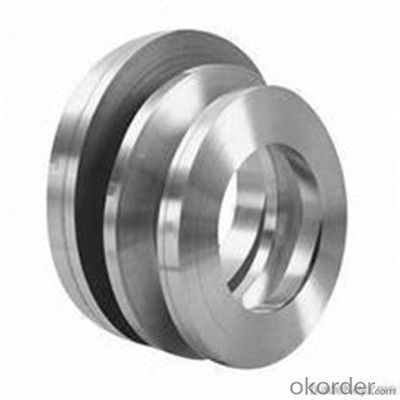
FAQ
1.What's your MOQ?
25MT, it is for one container.
2.Do you have QC teams?
Yeah, sure, our QC team is very important, they will keep the quality control for our products.
3. What's your normal delivery time?
Our delivery time about 10-20days for standard sizes, if you have other requirements like hardness and width ,it is about 20-40days.
- Q:How do steel strips contribute to product longevity in various applications?
- There are several ways in which steel strips contribute to the longevity of products in various applications. To begin with, steel strips possess remarkable durability and resistance to wear and tear. They can endure heavy loads, impacts, and harsh environmental conditions without easily becoming deformed or damaged. This strength and durability guarantee that products created with steel strips have a longer lifespan compared to those made with alternative materials. Furthermore, steel strips exhibit outstanding resistance to corrosion. They are frequently coated with protective layers, such as zinc or chromium, in order to prevent rusting and corrosion. This protective coating acts as a barrier, shielding the underlying steel from moisture, chemicals, and other corrosive elements. Consequently, products constructed with steel strips are less prone to corroding and deteriorating over time, ensuring their longevity. Moreover, steel strips offer a high strength-to-weight ratio, meaning they provide considerable strength while being relatively lightweight. This characteristic is particularly advantageous in applications where weight is a concern, such as in the automotive or aerospace industries. The utilization of steel strips allows for the production of lighter products without compromising their structural integrity and durability. Additionally, steel strips can be easily shaped and fabricated into various forms and sizes, making them highly versatile. This versatility enables manufacturers to create products tailored to specific applications, guaranteeing optimal performance and longevity. Furthermore, steel strips can be efficiently joined or welded together, enabling the construction of complex structures that are robust and long-lasting. Lastly, steel strips are recyclable. At the end of their lifespan, steel strips can be recycled and repurposed to manufacture new products. This recyclability not only reduces the environmental impact of steel production but also contributes to the sustainability of products made with steel strips. In conclusion, steel strips contribute to the longevity of products in various applications through their durability, corrosion resistance, high strength-to-weight ratio, versatility in shaping and fabrication, and recyclability. These characteristics ensure that products created with steel strips can withstand the test of time and continue to perform reliably for extended periods.
- Q:How do steel strips handle high-pressure applications?
- Due to their inherent strength and durability, steel strips are highly suitable for high-pressure applications. The properties of steel, such as its high tensile strength and resistance to deformation, make it an ideal choice for handling high pressure. This ensures the integrity and safety of the application, as steel strips can withstand significant amounts of pressure without bending or breaking. Moreover, steel strips can be tailored to the specific requirements of high-pressure applications by manufacturing them to precise specifications. They offer versatility and flexibility in their use, as they can be produced in various thicknesses, widths, and lengths. Additionally, steel strips can be further processed or treated to enhance their resistance to corrosion, wear, or other environmental factors, ensuring their longevity and performance in high-pressure conditions. Furthermore, steel strips can be easily formed and manipulated into different shapes or designs, making them adaptable to various high-pressure applications. Their ductility allows for the creation of complex structures or components that can withstand the forces exerted by high pressure. In conclusion, steel strips are an excellent choice for high-pressure applications due to their strength, durability, versatility, and ease of customization. They provide reliable and efficient solutions for industries and sectors that require the handling of high-pressure environments, ensuring the safety and effectiveness of the applications they are used in.
- Q:How are steel strips processed for surface etching?
- In order to achieve the desired result, steel strips undergo a series of steps for surface etching. Initially, the steel strips are thoroughly cleaned to eliminate any dirt, oil, or contaminants that may hinder the etching process. This is accomplished using chemical cleaners, solvents, and mechanical methods like scrubbing or blasting. Once the steel strips are clean, a protective layer, typically a photoresist or resistant mask, is applied to the surface. This layer acts as a barrier, safeguarding the areas that do not require etching. The subsequent step involves exposing the coated steel strips to a chemical etchant, commonly an acidic solution. The etchant selectively removes the unprotected areas of the steel, leaving behind the desired pattern or design. To achieve the desired depth and precision, the etching process can be regulated by adjusting factors like temperature, concentration, and duration of exposure. After the completion of the etching process, the remaining photoresist or mask is removed. This is usually done through a combination of chemical stripping and mechanical methods such as rinsing or scrubbing. Consequently, the etched pattern on the surface of the steel strips is revealed. To enhance the final appearance and protect the etched surface, additional post-etching treatments may be applied to the steel strips. These treatments include passivation, rinsing with water or other chemicals, and drying. They are crucial in eliminating any remaining etchant or contaminants, ensuring that the surface is clean and ready for further processing or application. In summary, the process of surface etching steel strips encompasses cleaning, coating, etching, removing the protective layer, and post-etching treatments. This process plays a vital role in various industries where etched steel strips find applications, such as electronics, automotive, and decorative fields.
- Q:How are steel strips used in the automotive aftermarket?
- Steel strips are commonly used in the automotive aftermarket for various purposes such as repairing and reinforcing vehicle components. They are often utilized to strengthen body panels, repair damaged frames, and reinforce structural parts. Steel strips can also be used to fabricate custom brackets, supports, or other specialized components, offering versatility and durability in the aftermarket automotive industry.
- Q:What are the different mechanical tests performed on steel strips?
- Some of the different mechanical tests performed on steel strips include tensile testing, hardness testing, bend testing, and impact testing. Tensile testing measures the strength and ductility of the steel by applying a pulling force until it breaks. Hardness testing determines the resistance of the steel to indentation or scratching. Bend testing assesses the steel's ability to withstand bending without cracking or breaking. Impact testing measures the steel's resistance to sudden, high-velocity loading by striking it with a pendulum or hammer. These tests help evaluate the mechanical properties and performance of steel strips in various applications.
- Q:What are the different surface coatings available for steel strips?
- Steel strips have several surface coatings available, each offering unique benefits and characteristics. Various common surface coatings include: 1. Zinc Coatings: To protect steel strips from corrosion, zinc coatings are widely used. These coatings can be applied through processes like hot-dip galvanizing, electroplating, or zinc-rich paint. Zinc coatings provide excellent corrosion resistance and are suitable for different environments. 2. Organic Coatings: For an appealing appearance, steel strips often have organic coatings like paints or powder coatings. These coatings not only enhance the aesthetics but also provide additional corrosion protection. They can be customized according to specific requirements, such as color or texture. 3. Phosphate Coatings: Steel strips are treated with phosphate coatings to improve corrosion resistance and create a suitable base for subsequent painting or powder coating. These coatings also enhance the adhesion of organic coatings, making them ideal for applications requiring paint or powder coating. 4. Chromate Coatings: Known as conversion coatings, chromate coatings are applied to steel strips to enhance corrosion resistance and improve adhesion of organic coatings. Industries demanding high corrosion resistance, such as automotive or aerospace, commonly use these coatings. 5. Tin Coatings: Steel strips often receive tin coatings to protect against corrosion. These coatings are frequently used in food packaging applications because tin is non-toxic and prevents the steel from reacting with food or beverages. 6. Aluminum Coatings: Exceptional corrosion resistance is provided to steel strips through aluminum coatings, such as aluminum-zinc alloy coatings. These coatings are commonly used in highly corrosive environments or for long-term outdoor exposure. 7. Epoxy Coatings: To achieve excellent chemical resistance and high durability, steel strips are coated with epoxy. These coatings find common use in industrial applications exposed to harsh chemicals or extreme conditions. When selecting a surface coating for steel strips, it is crucial to consider the specific requirements of the application. Factors such as corrosion resistance, aesthetics, adhesion, and environmental conditions should be taken into account to choose the most suitable coating.
- Q:How are steel strips measured and classified?
- Steel strips are measured and classified based on their dimensions, thickness, and mechanical properties. The measurement of steel strips typically involves three main parameters: width, thickness, and length. The width refers to the distance between the two edges of the strip, while the thickness is the distance between the top and bottom surfaces. The length, on the other hand, refers to the overall size of the strip. Steel strips are commonly classified based on their thickness. They can be categorized into thin, medium, or thick strips. Thin strips usually have a thickness of less than 3 mm, medium strips range from 3 mm to 10 mm, and thick strips have a thickness exceeding 10 mm. This classification is important as it determines the suitability of the steel strip for various applications, such as in the automotive, construction, or manufacturing industries. Moreover, steel strips can also be classified based on their mechanical properties. These properties include tensile strength, yield strength, elongation, hardness, and other relevant characteristics. These properties help determine the strength and durability of the steel strip, making it suitable for specific applications. For example, high tensile strength strips are commonly used in industries that require robust materials, while strips with good formability are preferred in industries that require complex shaping or bending. In addition to dimensions and mechanical properties, steel strips may also be classified based on their surface finish. This can include factors such as the presence of a protective coating or the level of smoothness. The surface finish is important as it impacts the appearance, corrosion resistance, and overall quality of the steel strip. Overall, the measurement and classification of steel strips involve considering dimensions, thickness, mechanical properties, and surface finish. Understanding these parameters is crucial in selecting the appropriate steel strip for a specific application, ensuring optimal performance and durability.
- Q:How do steel strips contribute to reducing product defects in various applications?
- Steel strips contribute to reducing product defects in various applications by providing a number of key benefits. Firstly, steel strips are known for their high strength and durability, which ensures that they can withstand various manufacturing processes without getting damaged or deformed. This reduces the likelihood of defects caused by material failure or deformation during production. Secondly, steel strips offer excellent dimensional stability, meaning they maintain their shape and size even under extreme conditions. This characteristic is crucial in applications where precision and accuracy are essential, as it helps prevent dimensional variations that can lead to product defects. Additionally, steel strips can be manufactured with tight tolerances, ensuring consistency in the thickness, width, and flatness of the strips. This level of precision minimizes the chances of defects caused by uneven or inconsistent material thickness. Moreover, steel strips often undergo surface treatments such as coatings or finishes, which further enhance their resistance to corrosion, abrasion, and wear. By protecting the surface of the steel strips, these treatments help prevent defects caused by environmental factors or friction during application. Furthermore, steel strips are often manufactured with specific mechanical properties, such as high ductility, hardness, or resistance to impact. These properties allow the strips to withstand the demands of various applications without compromising structural integrity, reducing the risk of defects caused by material failure. Lastly, steel strips are versatile and can be customized to meet specific application requirements. Whether it is through variations in alloy composition, thickness, width, or surface finish, manufacturers can tailor steel strips to suit different industries and applications, ensuring optimal performance and minimizing the potential for defects. Overall, steel strips contribute to reducing product defects in various applications by providing strength, durability, dimensional stability, precision, surface protection, mechanical properties, and customization options. These qualities combine to enhance the reliability, quality, and consistency of the final products, resulting in fewer defects and improved overall performance.
- Q:Can steel strips be used in the production of electronic components?
- Indeed, electronic components can be manufactured using steel strips. Due to their robustness, longevity, and capacity to conduct electricity, steel strips are frequently employed as a foundational material for an array of electronic components. The manufacturing process of printed circuit boards (PCBs), connectors, and other electronic parts often entails the utilization of steel strips. By offering a stable base, steel strips guarantee accurate alignment and secure attachment of electronic components. Moreover, these strips can be coated or treated to resist corrosion and enhance electrical conductivity, further rendering them suitable for electronic applications. In summary, steel strips present a dependable and economical option for producing electronic components.
- Q:What are the important considerations for storing steel strips?
- The important considerations for storing steel strips include proper environmental conditions, such as a dry and well-ventilated area to prevent rust or corrosion. It is also crucial to store them in a horizontal position to avoid warping or bending. Additionally, they should be stored away from any chemicals or substances that could damage the steel. Regular inspections and maintenance should be conducted to ensure their integrity and quality.
1. Manufacturer Overview |
|
|---|---|
| Location | |
| Year Established | |
| Annual Output Value | |
| Main Markets | |
| Company Certifications | |
2. Manufacturer Certificates |
|
|---|---|
| a) Certification Name | |
| Range | |
| Reference | |
| Validity Period | |
3. Manufacturer Capability |
|
|---|---|
| a)Trade Capacity | |
| Nearest Port | |
| Export Percentage | |
| No.of Employees in Trade Department | |
| Language Spoken: | |
| b)Factory Information | |
| Factory Size: | |
| No. of Production Lines | |
| Contract Manufacturing | |
| Product Price Range | |
Send your message to us
Hot Rolled Steel Strip Coil with Hardened&Tempered
- Loading Port:
- Tianjin
- Payment Terms:
- TT OR LC
- Min Order Qty:
- 77 m.t.
- Supply Capability:
- 2222777 m.t./month
OKorder Service Pledge
OKorder Financial Service
Similar products
New products
Hot products
Related keywords


